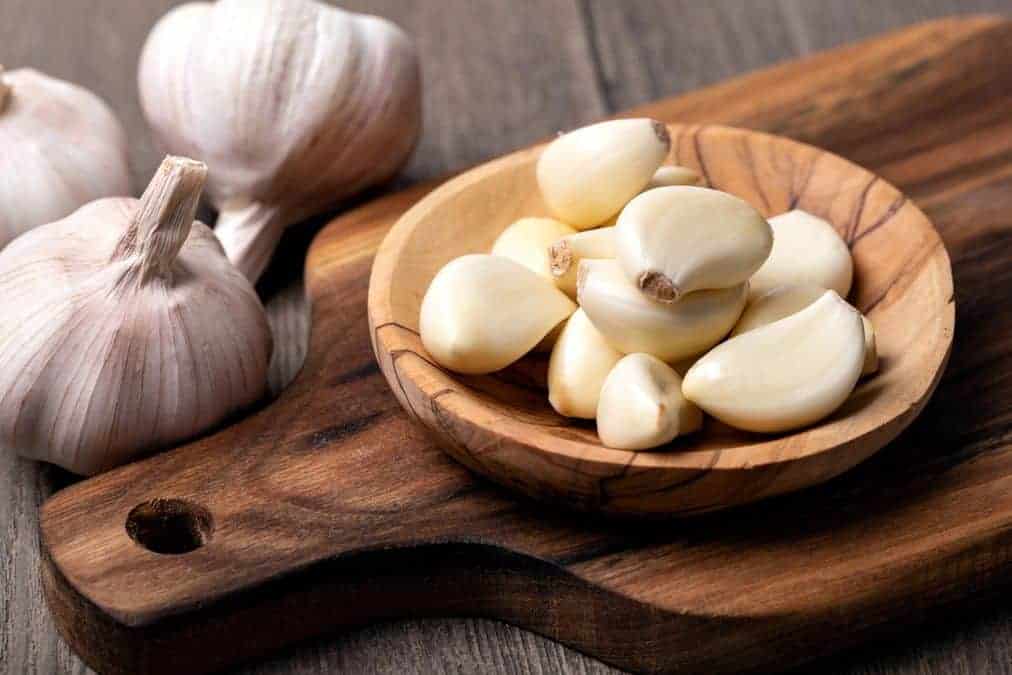
Garlic – a natural antibiotic with broad health properties
More or less serious health problems can happen to any of us, and it is best to start countering them as soon as we notice the first worrying symptoms. If we disregard them, they can quickly develop into a serious disease requiring long-term, often complicated and expensive treatment. That’s why proper preventive health care is so important, preferably using plants with proven healing properties, such as common garlic and other varieties, such as bear garlic.
Contents
- 1 What is common garlic and what is bear garlic?
- 2 What active substances can be found in the cloves of common and bear garlic?
- 3 How do common garlic and bear garlic affect the human body?
- 4 Are there contraindications and side effects that prevent eating garlic?
- 5 How can we prepare garlic for consumption?
What is common garlic and what is bear garlic?
Before we find out why the different types of garlic have earned the honorable and fully deserved title of “natural antibiotic”, we should learn about the two most commonly used varieties of this popular plant. It is used not only in the kitchen, as an additive that enhances the taste of many dishes, especially meat dishes, but also in herbal medicine, or phytotherapy, and the two most commonly used varieties of garlic are:
Common garlic

Also called common garlic (Alium sativum), it has been cultivated and known for thousands of years, originating in Central Asia. From there it spread practically all over the world, growing in different climatic zones, and is also cultivated commercially. It is a plant belonging to the amaryllis family, an herbaceous plant growing up to 1m tall, with long, narrow leaves.
Its most important part is the characteristic bulbs, which can be divided into several distinct parts, and these are the “cloves” of garlic. They are edible and it is in them that all the wealth of health-promoting nutrients is contained, although the pungent taste and slightly unpleasant smell will not be to everyone’s liking.
Nothing prevents you from eating them raw or after preliminary heat treatment, and they are also an important ingredient in many medicinal preparations, in the form of drops or tablets, which are definitely worth having in your home herbal medicine cabinet.
Bear garlic
Bear garlic (Allium ursinum) is another of the more than 300 varieties of this health-promoting plant, also known by other names, such as gypsy garlic or witches’ onion. It grows in the wild over large areas throughout Europe, and interestingly, its natural sites in Poland are under protection, so artificial cultivations are created for industrial purposes.
It is lower than the common garlic, its bushes grow to a maximum of 50 cm, and it does not produce bulbs, and edible are its lanceolate, 20-30 cm long leaves, and it is these that give off the characteristic smell and taste of garlic. On the other hand, do not eat the flowers, especially the white ones, which contain substances harmful to health and can cause serious food poisoning.
What active substances can be found in the cloves of common and bear garlic?
One of the reasons why garlic, both its common and bear varieties, are called a “natural antibiotic”, is their extremely rich composition. It contains virtually all the nutritional compounds that the human body needs to not only maintain full health, but, if necessary, also cope with the infections and diseases that attack it.
In the composition of common and bear garlic, it is worth distinguishing the following substances that determine their highly effective, positive effect:
- vitamin A;
- B vitamins: thiamine (B1), riboflavin (B2), niacin (B3), pyridoxine (B6);
- Vitamin C;
- beta-carotene;
- dietary fiber;
- polyphenols;
- flavonoids;
- phytosterols;
- organic acids;
- enzymes: allinase and peroxidase;
- sulfur compounds, such as allin, diallyl disulfide, diallyl trisulfide, or S-allilocytein;
- minerals: zinc, phosphorus, magnesium, potassium, selenium, sulfur and iron.
How do common garlic and bear garlic affect the human body?

The rich composition of garlic translates into the already mentioned exceptionally wide range of actions that promote the improvement of weakened health. It has been used in the prevention and support of treatment of various diseases for thousands of years, and in ancient times it was used, among other things, to relieve headaches and as an antiseptic and antibacterial agent for cleaning wounds.
Let’s face it, garlic is one of the healthiest edible plants, and proper doses of it are worth eating every day, not necessarily on its own, but as an addition to other easily digestible and non-fattening foods. Of all the medicinal properties of garlic, it is particularly worth highlighting:
Antibiotic-like action
Many of the ailments we may encounter require the use of antibiotics, which combine effectiveness with a large number of possible side effects at the same time. That’s why in many, though not all cases, it’s worth considering using garlic preparations, or administering it in another form. It strengthens a weakened immune system, and is recommended especially during the autumn and winter months.
It also proves extremely useful in supporting the treatment of the common cold and other such seasonal infections. This is thanks to its strong antiviral and antifungal properties, stronger than in other plants used in phytotherapy. It can be successfully used to inhibit Candida albicans fungi, for example.
Antibacterial action
It is especially excellent for various bacterial infections and infections, showing great effectiveness against many groups of these pathogenic microorganisms. In terms of potency, it can be confidently compared to pharmaceuticals, with experts highlighting its effectiveness against such Gram-positive and Gram-negative bacteria as Escherichia coli, Staphylococcus aureus, and Streptococcus pneumonia, for example.
LDL cholesterol reduction
Excess “bad” cholesterol in the blood, its particularly harmful fraction LDL, significantly increases the risk of dangerous cardiovascular diseases, primarily atherosclerosis. Regular use of dietary supplements that have garlic in them reduces the number of particles of the LDL fraction and at the same time raises the level of HDL cholesterol, which is beneficial for health.
Improving the work of the heart and circulatory system
The comprehensive effects of garlic on the heart and other components of the circulatory system are worth appreciating. Introducing it into your daily diet allows you to avoid not only atherosclerosis, but also other equally dangerous conditions. Among other things, garlic counteracts the phenomenon of aggregation, or the sticking together of platelets, which can lead to life-threatening venous congestion.
It also helps lower blood pressure that is too high, so it can become an important element in the prevention of hypertension, and the active compounds it contains help protect against stroke and heart attack. This is thanks to the fact that garlic has precisely the effect of reducing the viscosity of blood and improving the dilation of blood vessels.
Antioxidant and anti-cancer properties
One of the important factors that can cause the development of many diseases, including cancer, is the high activity of free radicals, or reactive oxygen species, called ROS for short. Garlic contains numerous antioxidants, or compounds that help remove free radicals from the body, such as beta-carotene, polyphenols and, most importantly, vitamin C, or ascorbic acid.
Studies conducted on the anti-cancer effects of garlic have shown that its regular consumption is recommended for the prevention of this disease, being able to reduce the risk of developing certain cancers, such as breast, colon and pancreas. The antioxidants, along with potassium and zinc, also benefit the condition of the skin, giving it a healthy and youthful appearance, without disfiguring discoloration or acne lesions. It is also worth using it on weakened, brittle and hair that is prone to falling out.
Improve the work of the digestive system
If you introduce garlic into your menu, its positive effects will also be felt by the digestive system. Adequate amounts of garlic, according to the recommended standards, can contribute to increasing the production of gastric juices necessary for proper digestion.
It also stimulates the liver and bile synthesis to work, counteracts excessive gas accumulation, supports the course of metabolic processes, which promotes rapid weight reduction. At the same time, it normalizes the intestinal microflora and facilitates the removal of harmful bacteria and parasites, such as tapeworm and human roundworm.
Are there contraindications and side effects that prevent eating garlic?
The numerous medicinal properties and benefits of eating both varieties of garlic cannot be denied. Unfortunately, not everyone can take advantage of its benefits, specialists in healthy eating point out important contraindications that prevent the consumption of gar lic and are definitely not recommended:
- children under the age of 12;
- people with gastric and duodenal ulcers;
- with liver disease and intestinal infections;
- in inflammatory conditions of the kidneys;
- with increased symptoms of decreased blood pressure and hypertension;
- to pregnant and lactating women.
As for the possible side effects of eating garlic, they mostly occur only if the recommended daily dose is exceeded, a maximum of 5 g, or 2-3 cloves, and the most common side effects are:
- severe burning in the mouth;
- abdominal pain;
- bloating and heartburn;
- painful reddening of the epidermis;
- irritation of the stomach and intestines.
How can we prepare garlic for consumption?

By far the most benefits are gained by eating fresh garlic, so you can be sure that it will not lose any of its nutritional valuesits nutritional and medicinal properties, but be sure not to exceed the recommended daily allowance listed above.
A good idea, which our grandmothers already knew, is to prepare a syrup of garlic, you only need to blend two heads of garlic, set it aside for several minutes, and then mix it with fresh lemon juice and a glass of boiled water. After pouring into an airtight container, we put the syrup in the refrigerator and wait 2-3 days, and drink it in the amount of 1 tablespoon a day.
We realize that the taste of raw garlic or syrup made from it, will not appeal to everyone, so you can instead use dietary supplements in the form of tablets, in which it is the main active substance. The smell of garlic in them is practically undetectable, but its 100 percent effective effect is preserved.
Sources:
- https://www.healthline.com/nutrition/11-proven-health-benefits-of-garlic
- https://www.healthline.com/nutrition/garlic-and-ginger-benefits
- https://www.healthline.com/nutrition/too-much-garlic
- https://www.healthline.com/health/foods-healing-power-garlic
- https://www.healthline.com/nutrition/garlic-fights-colds-and-flu



